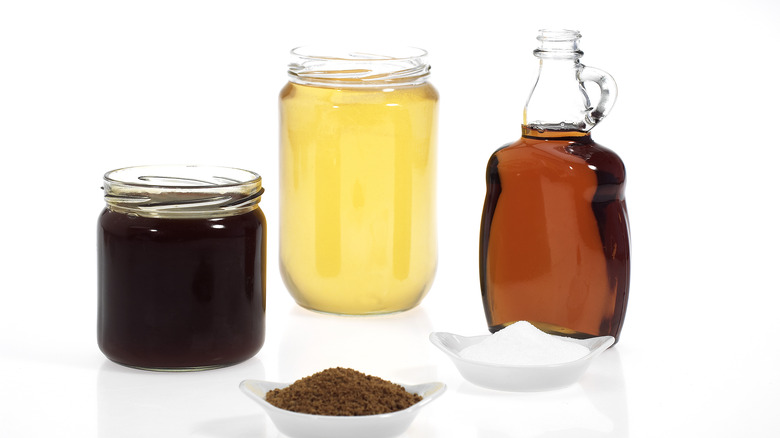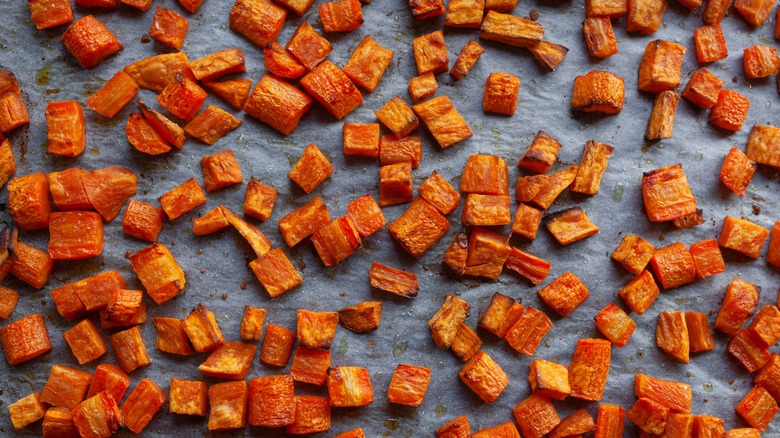The Unexpected Ingredients That'll Easily Sweeten Your Chili
Americans take their chili very seriously. Ever since it emerged from the Southwest sometime in the late 1800s, chili has galvanized — and polarized — cooks and chefs from coast to coast. Whether you're steadfast in the belief that chili should never have beans, or you believe the more beans, the better, most chili makers agree that there has to be some sweetness to balance out the spice and acidity from the tomatoes. The obvious way to round out your chili recipe is to add a tablespoon or two of table sugar to the mix, but where's the fun in that? If you want to create a truly unique, signature chili recipe worthy of cook-off status, try working with some unexpected ingredients to add sweetness and flavor.
Chili, in its most basic form, is a spicy, often tomato-based stew that typically has earthy notes of cumin and other spices, so if you want to add some sweetness without using white sugar, look to ingredients that work well with spicy tomato sauce and chili spices. There are lots of unrefined sweeteners to experiment with, or you can use naturally sweet root vegetables or even a few fruits to get a pop of sugary complexity.
Unrefined sugars
The easiest way to add a little sweetness to an existing chili recipe is to reach for the sugar bowl, of course. The problem is that ordinary white sugar doesn't have much flavor other than just sweet, so it's better to look for unrefined sources of sweetness that have a little more complexity if you want to add sugar to your chili. J. Kenji López-Alt, for instance, adds a couple of tablespoons of dark brown sugar to his go-to recipe, which gives off complex caramel notes. Bobby Flay, on the other hand, reaches for maple syrup for an unexpected twist.
You could also use coconut sugar, which will give your chili similar caramel notes as brown sugar but with a summery coconut undertone. Or, add a few tablespoons of molasses for gingery, smoky flavors. Any alternative sugar is fair game, including honey, malt sugar or extract, and even a cup or so of a sweet beer, like milk stout or German hefeweizen, will add sweetness and character. Ketchup is also basically just sweetened tomato paste, so you can squeeze a few tablespoons into your next chili batch. Just don't go overboard; a little natural sugar goes a long way in a chili recipe. All you're trying to achieve is balance, not perceived sweetness, which is a flaw you'll have to correct later if you use too much sugar.
Sweet fruits and vegetables
Adding sugar isn't the only way to sweeten up your chili, however. If you're looking for ingredients that can also add some volume and texture, there are plenty of vegetables and even fruits that can do the job. Root vegetables like carrots, parsnips, beets, and sweet potatoes or yams will add a subtle sweetness to the mix. Plus, if you roast your veggies first, they'll have toasty caramel notes. This works especially well for onions, which have lots of natural sugar, and you were probably already going to add them anyway. Corn is also a great sweetener, and even if you don't want whole corn kernels in your chili, you can pureé fresh corn for a natural sugar boost.
Certain fruits will also taste great and add sweetness to chili, including apples and pumpkin. The easiest way to add subtle apple sweetness is to mix in a cup of unsweetened applesauce. The same is true for using pumpkin purée, but you can also use fresh pumpkin that's diced small. Again, try roasting the pumpkin pieces before you add them to your chili for extra flavor and sweetness.
Unless you're planning to compete in a chili cook-off, the only rule of chili making is to make it taste good, so don't be afraid to mix and match unconventional ingredients until you come up with the perfect chili sweetener.


